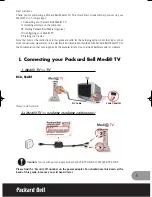
2
1
ANTENNA SYSTEM
Antenna and tuners
■
If your Icom HF system is going aboard a sailboat,
you may use an insulated backstay to make up your
antenna system. Your best range will be from an in-
sulated backstay because of the long length of the
antenna element which is that portion between the
top and bottom insulators. Have your rigger put the
top insulator about at least 1 meter down from the
tip of the mast. Have your rigger install the bottom
insulator at about eye-level when you’re standing
back aft. (This length between insulators should not
exceed 37 meters or be less than 7 meters.)
This non-resonant antenna can be tuned by the Icom
automatic antenna tuner that matches your trans-
ceiver. The tuner is connected to the transceiver. We
suggest you use “GTO-15” high voltage lead-in wire
from the single wire output of the tuner to your in-
sulated backstay. This high voltage wire won’t break
down in wet weather or sunlight. Use stainless steel
hose clamps to attach the wire to the insulated back-
stay.
The tuner is fed with a coaxial and a control cable
from the Icom transceiver.
Check with your dealer regarding antennas and ca-
bling.
R
DANGER: HIGH VOLTAGE!
NEVER
touch the antenna element while tuning
or transmitting.
Insulator
Antenna element
Antenna element
Ship’s
ground
Insulator
Insulator
Antenna
tuner
To
transceiver
Antenna
tuner
The importance of grounding
■
Surface area to the sea water and the use of copper
foil exclusively throughout your RF ground system is
the combination that gives you reliable long range
communications. The sea water gives your signal a
solid surface to push off from. This is called a “coun-
terpoise,” and it’s the necessary “other-half” of your
antenna system that must be achieved for your over-
all HF transceiver system to work well.


































